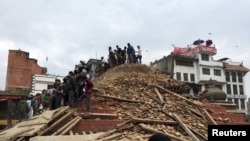VOA's Southeast Asia correspondent Steve Herman is closely following the unfolding disaster in Nepal and nearby nations. He described what happened after the Earth's crust shifted and unleashed the major earthquake that shook the Himalayan region Saturday.
"It's pretty grim in Kathmandu and areas that were close to this shallow and extremely powerful quake, the largest to have hit Nepal in about 80 years. The U.S. Geological Service is estimating there could be between 1,000 and 10,000 people dead."
Q: How have Nepal's historic sites been affected?
"Much of Nepal's heritage has been destroyed by this earthquake. Many shrines, many temples have crumbled. A lot of the older buildings in Kathmandu have gone down. One eyewitness who was surveying the scene with binoculars estimated that 20 percent of the buildings in Kathmandu have been destroyed."
Q: What happened on Mount Everest?
"There have been avalanches on both the north and south sides of Everest. It is the Nepali side of the mountain that seems to have suffered the most damage, in terms of the base camps and the climbers. We're hearing that several Chinese mountaineers have died.
"In all, according to reports from the scene, eight bodies have been recovered. We're told that at Base Camp One, although there was damage, apparently everyone there did survive. If there were climbers up on the mountain at the time — and it appears that there were — it would be some time before we can determine what their fate is.
"Also we're getting information that the mountaineers' route up and down the mountain has been damaged, and so some climbers may have been cut off. Of course, that's not an easy place to arrange a rescue."
Q: What is the situation regarding infrastructure and aid supplies?
"It's a dire situation in Kathmandu and other places. The water supply is out. Ambulances are having a difficult time reaching the victims because of damage to the roads. The Indian air force is flying in some aircraft with search-and-rescue teams and supplies. And we can expect that in the coming days, there are going to be a number of other countries bringing in rescue teams and supplies.
"At the moment this is very challenging. If the road is passable, say, from West Bengal in India, it's a 10- to 12-hour drive to get to Kathmandu. The airport has been closed; they're assessing damage. Until they can get that airport open, it's going to be a challenge to get in any cargo aircraft or commercial aircraft. At this point it does appear to be a military-type operation, but a number of NGOs that we've been in contact with are gearing up to come in with a massive relief effort."
